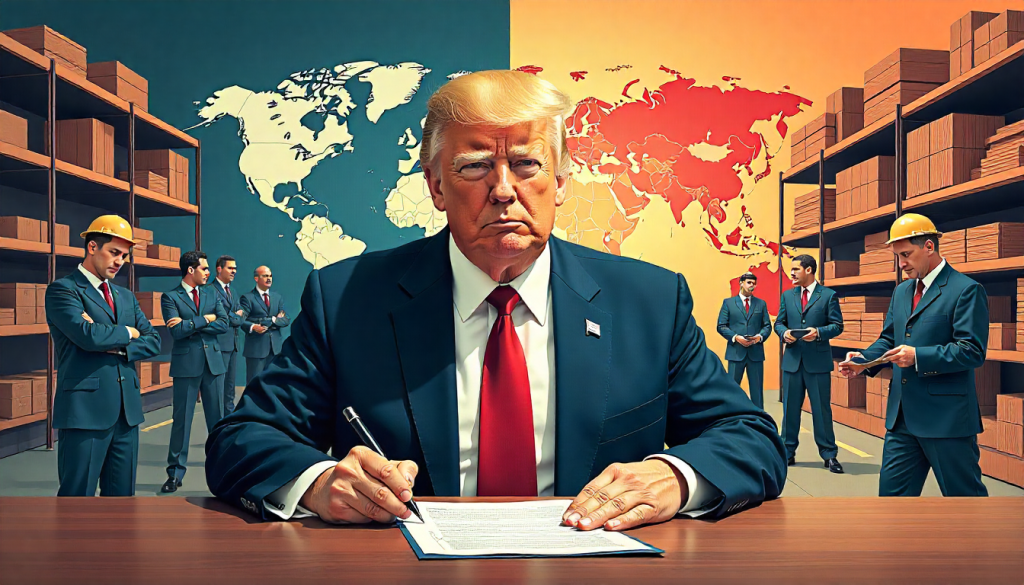Introduction
The U.S. government has proposed a broad list of new tariffs that target several nations, including some of its closest trading partners, in a move that has generated intense controversy in international markets. Diplomatic circles, stock markets, and industry are already feeling the effects of these actions. The discussion of Trump’s proposed tariffs and global trade is about more than simply economics; it’s also about how U.S. foreign policy is changing and how it might affect supply chains throughout the world.
What Tariffs Did Trump Just Announce?
Targeting industries ranging from electronics, textiles, and vehicles to steel and aluminum, the new taxes are extensive. Important modifications consist of:
- 20–25% higher import taxes on aluminum and steel
- 15% tax on specific consumer electronics categories
- increased taxes on auto parts imported from other nations
- Increased agricultural import duties on specific food items
These policies increase world trade costs by billions of dollars and impact goods from the European Union, Canada, India, China, and other Southeast Asian economies. Opponents warn of increasing retribution, while supporters claim they would safeguard American manufacturing and jobs.
Why Is the U.S. Raising Tariffs on China, Canada, India & Others?
Officially, the administration claims that the additional tariffs are intended to “level the playing field” and shield American workers from unfair competition. Addressing China’s alleged intellectual property infringement, closing the trade gap with important allies, forcing friends to renegotiate trade agreements, and safeguarding strategic industries considered essential to national security are some of the justifications. Many economists contend that these tariffs are politically driven and may have unintended consequences. Trump’s new tariffs run the danger of upsetting both friends and rivals by targeting both strategic adversaries like China and longstanding allies like Canada, perhaps eroding the very economic ties they are meant to fortify.
Is the U.S. Breaking Trade Diplomacy?
Trade diplomacy has traditionally relied on negotiations, mutual concessions, and adherence to World Trade Organization (WTO) rules.
By implementing sweeping tariffs without extensive multilateral dialogue, the U.S. risks undermining trust in established trade systems.
Critics argue:
- This move signals unilateralism over collaboration.
- It may violate WTO commitments, inviting legal disputes.
- Allies could respond with counter-tariffs, escalating trade wars.
Many trade experts see these measures as a departure from decades of U.S.-led free world trade advocacy, creating uncertainty about the country’s long-term role in the global economy
How Markets & Businesses Are Already Reacting
Almost instantly, financial markets reacted. While domestic steel producers experienced short-term gains, the stock values of manufacturing and export-dependent industries fell. Concerns regarding increased manufacturing costs and possible job losses in industries that depend on imported components have been voiced by significant industry associations.
Business responses consist of:
- Manufacturers are complaining about decreased competitiveness and increased input costs.
- Retailers expecting consumer goods prices to rise
- Exporters worry that impacted countries will impose retaliation tariffs.
For many businesses, the uncertainty is just as detrimental as the tariffs. Planning for the future is becoming more challenging due to the uncertainty surrounding Trump’s new tariffs and world trade.
What Does This Mean for Global Supply Chains?
Global Supply Chain Disruption – Modern supply chains cross multiple borders; tariffs create bottlenecks and raise costs at each stage.
Production Relocation – Companies may shift manufacturing to non-tariff countries, though this comes with added setup costs.
Regional Trade Shift – Increased reliance on world trade agreements outside the U.S., reducing its global influence.
Higher Consumer Prices – Disruptions lead to delays, inefficiency, and price hikes for end products.
Short-Term Supplier Gains – Countries like Vietnam, Mexico, and Indonesia may benefit briefly, but global trade growth could slow overall.

Is This a Short-Term Move or a Shift in Policy?
The primary inquiry is whether these tariffs serve as a temporary negotiating tool or indicate a more enduring protectionist approach. Historically, announcements regarding tariffs have occasionally been utilized as leverage during trade discussions, often being reduced in return for concessions.
Nevertheless, current indications imply that:
- The administration is willing to uphold tariffs as a component of its comprehensive economic strategy.
- Political factors may necessitate the continuation of these measures at least until the forthcoming election cycle.
- Long-term alterations in supply chains could establish new trade patterns, even if tariffs are subsequently diminished.
If maintained, Trump’s revised tariffs and global trade strategy could result in a transformed global trade landscape one that circumvents traditional U.S.-led frameworks.
Conclusion
Tariffs have long been a potent economic instrument, but there are hazards associated with their application. Higher prices, damaged diplomatic ties, and interrupted supply chains are the immediate results of Trump’s new tariffs on global commerce. Consumers, companies, and governments worldwide will be impacted whether or not the strategy meets its declared objectives.
Adaptability becomes a vital survival skill during unpredictable political and economic times, for professionals and enterprises alike. Platforms like Wiraa are essential in this situation. Wiraa, a platform for remote work, links talent with opportunities around the world, assisting professionals in navigating changing economic conditions and maintaining their competitiveness in evolving markets. Because even though tariffs can change how things move, there will always be a need for qualified, flexible workers.




